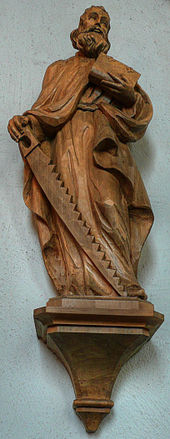Simon Zelotes

Simon Zelotes († probably in Babylon in the 1st century , today Han-al-Mahawil in Iraq ) was an apostle of Jesus Christ . The older church tradition sees him as a cousin of Jesus, as does Judas Thaddäus .
Life
Simon Zelotes was one of the twelve apostles of Jesus (Mt 10.4; Mk 3.18; Lk 6.15; Acts 1.13). His nickname Zealot, in Aramaic "Kananäu" the Germans "the Zealot" he probably was due to its original membership of radical zealots party that had set itself the goal of Roman expel occupiers by force. In the New Testament , this name appears in the Apostle lists; other details are missing. In older Bible translations the name was misrepresented as "Simon the Canaanite ".
Simon Zelotes and the gentleman brother Simon
According to Catholic tradition, Simon Zelotes was a brother of James the Younger and closely related to Jesus. His mother, Maria Cleophae , was one of the holy women under his cross and his father Cleopas was a half-brother of St. Joseph . The Bible mentions a Simon and James the Righteous as brothers of Jesus. The Catholic tradition, because of the dogma of the perpetual virginity of Mary , refuses to take the term “brothers” literally in this context. Among other things, this results in the equation of Simon Zelotes with the gentleman brother Simon, who later became leader of the Jerusalem early church , and the equation of James the Younger with James the Righteous.
In contrast, the evangelical tradition sees James the Just and the later church leader Simon, in a more literal interpretation of the Bible, as the biological sons of Mary, the mother of Jesus, and Joseph, his foster father, i.e. younger half-brothers of Jesus. From this point of view, it is forbidden to equate Simon the Zealot with the church leader Simon and James the Younger with James the Righteous.
The assessment of the arguments of various book authors on these questions is therefore difficult without taking into account their denominational affiliation, a definitive answer can therefore not be given here.


Lore
After the crucifixion of Christ Simon preached the Gospel in Babylonia and Persia , where he together with Jude Thaddeus the martyrdom to have suffered. It is said to have been sawed up. In Christian art he is therefore usually represented with the attribute of the saw. According to other tradition, he was the bishop of the early community . After the siege and destruction of the city by Titus , he and his community returned to the ruins . In 107 he is said to have been crucified at the age of 120 during the persecution of Christians by Emperor Trajan .
Patronage
As church patron u. He usually appears together with Judas Thaddäus as "Saints Simon and Judas" (as in the former imperial cathedral in Goslar and on the so-called Goslar farmgroschen ). The saint is the patron saint of dyers , tanners , woodcutters and leather workers . Relics attributed to him are mainly kept in Rome , Cologne , Bad Hersfeld and Sayn . He is one of the canon saints of the Catholic liturgy.
Attributes
The attributes of the saint include the saw , the hatchet and the club .
Memorial days
The Catholic , Evangelical and Anglican Remembrance Day of Simon the Apostle is October 28th, along with Jude Thaddeus . The Orthodox Memorial Day is May 10th. The Catholic feast day of Simeon the Bishop of Jerusalem is February 18th. According to more recent findings, the apostle and the bishop could have been the same person, but the evaluation of the argument depends on the denomination (see above).
Pawn rule
The the name- appropriate Bauer rule is: "He who sows wheat on Simon Day (October 28), which he wears golden ears without question."
See also
Web links
Individual evidence
- ↑ The great book of saints p. 114 f.
- ↑ z. B. Evangelische-Liturgie.de
- ↑ a b Erna and Hans Melchers - The great book of saints. History and legend throughout the year . Südwest Verlag GmbH & Co. KG., Munich 1978, p. 115
- ↑ a b c The great book of saints. P. 114
| personal data | |
|---|---|
| SURNAME | Simon Zelotes |
| BRIEF DESCRIPTION | Disciples of Jesus Christ |
| DATE OF BIRTH | 1st century BC BC or 1st century |
| DATE OF DEATH | 1st century |
| Place of death | uncertain: Babylon (today: Han-al-Mahawil , Iraq ) |
